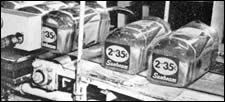No. 2 - Polypropylene
The invention of PP was nearly simultaneous in the U.S. and Europe.
The invention of PP was nearly simultaneous in the U.S. and Europe. Today, PP is the largest volume commodity thermoplastic. The American Plastics Council (APC) pegs North American PP consumption last year at 16.446 billion lb. This compares with 6.438 billion lb for LDPE, the only polyolefin that existed prior to 1955.
In 1953, Prof. Giulio Natta at Milan Polytechnic in Italy further developed the breakthrough of that same year by Prof. Karl Ziegler at the Max Planck Institute for Coal Chemistry in Germany. Prof. Ziegler discovered that titanium tetrachloride could catalyze stereospecific polymerization of polyethylene. With financial aid from Montecatini (later Montedison), a large Italian chemical company, Prof. Natta extended Prof. Ziegler’s discovery to the development of isotactic PP, which Montecatini was the first to produce on an industrial scale in 1957 in its Ferrara plant. At NPE 1956, Montecatini exhibited PP film and monofilaments.
In the U.S., meanwhile, Paul Hogan and Robert Banks of Phillips Petroleum (now Chevron Phillips) were experimenting with high-octane gasoline when they discovered high-melting crystalline PP in 1952. Phillips did not start commercial production of PP until the early ’60s. The first commercial producer in the U.S. was Hercules Powder Co. (bought by Montedison and ultimately part of Basell) in 1958. Others quickly followed.
By NPE 1958, PP homopolymers were available from Hercules, Chemore, Spencer Chemical (marketing for Exxon), and Capac Plastics. Besides Montecatini, Hoechst in Germany and ICI in England were bringing on commercial capacity. Avisun Corp. soon after was producing PP homopolymer and random copolymer at New Castle, Pa. Although Montecatini was first to make both random and impact copolymers, Avisun introduced the first impact copolymers in the U.S. at NPE ’61, with Hercules and others soon to follow. Avisun was acquired by Amoco in 1967.
Among the very first commercial PP applications were monofilaments for fabrics, carpets, and ropes, as well as clear, biaxially oriented (BOPP) films used as replacements for cellophane in cigarette wrap, bread wrap, and retail packaging for shirts and other garments. Closely following in the late 1950s and early ’60s were extruded pipe, strapping, drinking straws, and wire/cable coatings. One of the first injection molded products was a two-piece bed pan. This was followed by a variety of electrical parts, washing-machine tubs and impellers, hypodermic syringe barrels, medicine bottles, and food containers. A big breakthrough was the screw cap with a living hinge for Seagram’s liquor bottles. This essentially knocked polystyrene out of the closure business and led the way for PP into all types of consumer bottle caps.
By the early 1960s, PP and its copolymers were being used in several automotive applications. This included the use of impact copolymers for battery cases and fender liners, random copolymers for washer-fluid reservoirs, and filled homopolymers for air-intake and heater ducting. Impact copolymers were soon used for auto door interior trim and liners, as well as dashboards. There is currently an average of more than 50 lb of PP used in an automobile.
In the late ’60s, blow molded containers, such as bottles for detergents, food, shampoos, and other liquids, made a splash. The first was for Procter & Gamble’s Dawn dish soap in 1967, which initially was made by the Phillips Orbet extrusion stretch-blow molding process, made obsolete a decade later by PET injection stretch-blow molding. PP’s impact resistance and ease of blow molding soon spawned applications such as ice chests, water coolers, housewares, toys, furniture, appliance housings, dairy containers, and snack-food packaging (metalized BOPP film).
Read Next
Lead the Conversation, Change the Conversation
Coverage of single-use plastics can be both misleading and demoralizing. Here are 10 tips for changing the perception of the plastics industry at your company and in your community.
Read MoreHow Polymer Melts in Single-Screw Extruders
Understanding how polymer melts in a single-screw extruder could help you optimize your screw design to eliminate defect-causing solid polymer fragments.
Read More





















